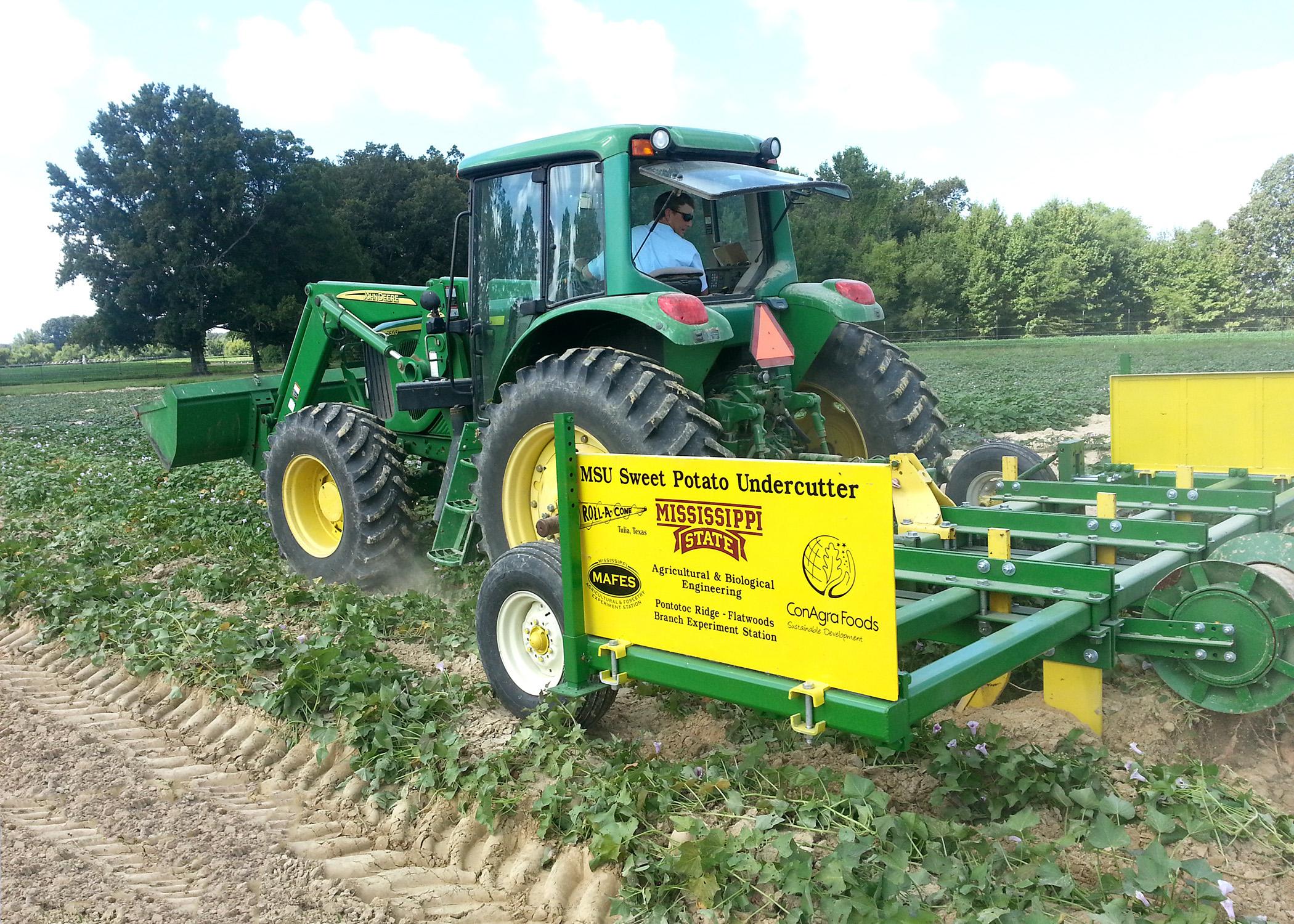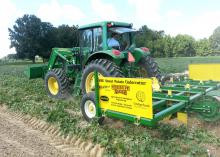Information Possibly Outdated
The information presented on this page was originally released on September 20, 2013. It may not be outdated, but please search our site for more current information. If you plan to quote or reference this information in a publication, please check with the Extension specialist or author before proceeding.
Sweet potato undercutter studies show promise
MISSISSIPPI STATE – A machine designed by a group of Mississippi State University researchers could help sweet potato farmers reduce skinning injury to potatoes and speed up harvest.
The undercutter prototype, made from off-the-shelf components, shows early potential to help lower harvest and post-harvest losses caused by skinning, said Jason Ward, assistant Extension professor in MSU’s Agriculture and Biological Engineering Department. Problems stemming from skin abrasions that happen during digging and handling account for 20 to 25 percent of storage losses, he said.
The undercutter digs below the surface with a V-shaped blade to cut the roots that feed the potato from the soil. This stops the flow of nutrients and water to the potato and induces a state of shock that causes the skin to toughen, Ward said.
“Our preliminary studies show some increased skin strength in some varieties,” Ward said. “But we still have some questions to answer about whether undercutting improves storage performance and translates into value for the grower.”
The MSU prototype can undercut two 40-inch rows and can be adjusted to standard row spacing. It is constructed with a homemade toolbar and attachments from Roll-A-Cone Manufacturing.
“This is not the only undercutter out there,” Ward said. “This approach is used in other crops, but we built this one with existing parts that can be purchased now,” Ward said. “After we establish that it works and how best to use it, a grower can quickly adopt this system and likely start with parts they already have on hand.”
Whether growers sell their potatoes in the fresh market immediately after harvest or in a year-round market, storage losses are a concern.
“A sweet potato’s skin is its first line of defense against organisms that might cause spoilage,” said Stephen Meyers, regional sweet potato specialist with MSU’s Extension Service. “If the skin is damaged, the sweet potato, which is 85 percent water, is more prone to lose moisture and subsequently weight. Weight loss translates to lost revenue for sweet potato farmers and reduces the quality of the sweet potato. Sweet potatoes with excessive damage to the skin won’t sell in the fresh market because they don’t look good.”
A faster skin set would allow growers to harvest large numbers of potatoes quickly, allowing growers to keep enough potatoes on hand to sell all year.
“The greater goal of this study is to give more growers the opportunity to market their potatoes year-round by giving them a wider window in which to store them,” Ward said. “What we want to understand with this study is how pre-harvest, harvest and post-harvest practices can be combined with the use of this undercutter to hasten the toughening of the potatoes’ skin before they are dug and harvested. By offering growers another method to encourage skin set, we’re adding tools to their toolbox.”
Currently, most growers start the skin strengthening process by removing the above-ground vines five to seven days before harvest. This method also brings about a state of shock to the sweet potatoes, said Ramón Arancibia, MSU assistant research professor with the Mississippi Agricultural and Forestry Experiment Station in Pontotoc.
“Chemicals, such as those used to defoliate the common potato, have been tested in sweet potato, but they have not been registered for use in sweet potatoes,” Arancibia said. “So we are looking at several different methods to toughen the skin. This particular undercutter is expected to lessen the number of days between the treatment (undercutting) and harvest.”
The prototype is undergoing a number of field tests at MSU’s Pontotoc Ridge-Flatwoods Experiment Station and in Vardaman and Arkansas. Ward said the machine could undergo more modifications depending on the test results.
The one-year-old study is funded by MAFES, the U.S. Department of Agriculture-Specialty Crops Research Initiative and ConAgra Foods. Others involved in the study are Mark Shankle, MAFES research professor at the Pontotoc Ridge-Flatwoods Branch Experiment Station; Jeremiah Davis, associate professor; Wes Lowe, research associate; and Bradley Hayes, graduate research assistant, all members of MSU’s Department of Agricultural and Biological Engineering.






